Trinity Church is a historic parish in the Episcopal Diocese of New York, whose church is located at 89 Broadway opposite Wall Street, in the Financial District of Lower Manhattan in New York City. Known for its centuries of history, prominent location, distinguished architecture and bountiful endowment, Trinity's congregation is said to be "high church", its activities based on the traditions of the Episcopal Church and the worldwide Anglican Communion in missionary outreach, and fellowship. In addition to its main church, Trinity parish maintains two chapels: St. Paul's Chapel, and the Chapel of St. Cornelius the Centurion on Governors Island. The Church of the Intercession, the Trinity Chapel Complex and many other of Manhattan's Episcopal congregations were once part of Trinity parish. Columbia University was founded on the church's grounds as King's College in 1754.

St Dunstan's, Stepney, is an Anglican church which stands on a site that has been used for Christian worship for over a thousand years. It is located in Stepney High Street, in Stepney, London Borough of Tower Hamlets.
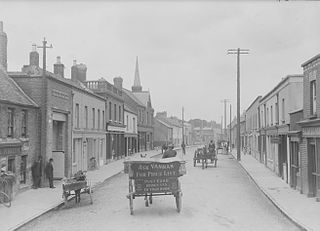
Rathfarnham is a southside suburb of Dublin, Ireland in County Dublin. It is south of Terenure, east of Templeogue, and is in the postal districts of Dublin 14 and 16. It is between the local government areas of Dún Laoghaire–Rathdown and South Dublin.

Drumcondra is a residential area and inner suburb on the Northside of Dublin, Ireland. It is administered by Dublin City Council. The River Tolka and the Royal Canal flow through the area.

St Mary le Port is a ruined parish church in the centre of Bristol, England, situated in Castle Park on what remains of Mary le Port Street.

St Mary's Church, Dublin is a former Church of Ireland building on the corner of Mary Street and Jervis Street, Dublin, adjacent to Wolfe Tone Square. From the 17th century, the church was a place of worship for parishioners on Dublin's northside, before it was closed in 1986. The church has since been deconsecrated and the building is now a pub and restaurant. The parish also had a chapel of ease - St Mary's - off Dorset Street, more commonly known as "The Black Church".
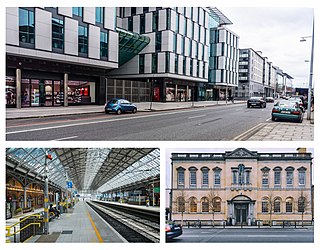
Pearse Street is a major street in Dublin. It runs from College Street in the west to MacMahon Bridge in the east, and is one of the city's longest streets. It has several different types of residential and commercial property along its length.

Colchester in Essex, England, has a number of notable churches.
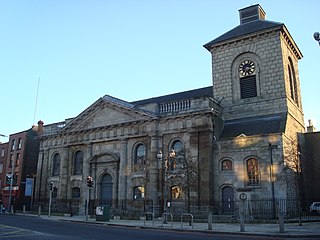
St. Catherine's Church, on Thomas Street, in Dublin, Ireland, was originally built in 1185. It is located on what was once termed the "Slí Mhór", a key route that ran westwards across Ireland from Dublin. The church was rebuilt in its present form in the 18th century by John Smyth.

St. George's Church is a former parish church in Dublin, Ireland. Designed by Francis Johnston, it is considered to be one of his finest works. The structure is located at Hardwicke Place, just north of the city centre, though when it was opened this was considered to be in Drumcondra. The elegant spire, 200 feet (61.0 m) high, became a landmark of the north inner city. Along with St Andrew's Church, Chennai, it is considered one of the finest stylistic "daughter" churches to London's St Martin-in-the-Fields.

Mercer's Hospital was a hospital in Dublin, Ireland. It was converted into a clinical centre and medical library for the Royal College of Surgeons in Ireland in 1991.

St. Bride's Church was a Church of Ireland church located at the corner of Bride Street and Bride Road, Dublin, Ireland.
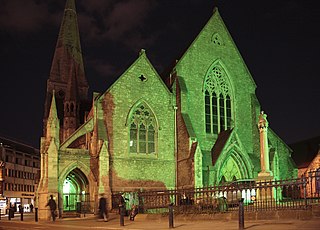
St Andrew's Church is a former parish church of the Church of Ireland that is located in St Andrew's Street, Dublin, Ireland. After ceasing to be a church, it housed the main Dublin tourist office of Fáilte Ireland until 2014, and later underwent redevelopment with a view to reopening as a food hall.
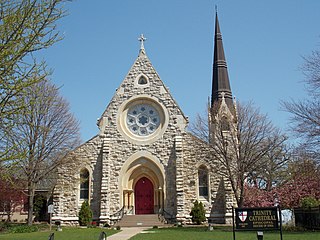
Trinity Episcopal Cathedral, formerly known as Grace Cathedral, is the historic cathedral in the Diocese of Iowa. The cathedral is located on the bluff overlooking Downtown Davenport, Iowa, United States. Completed in 1873, Trinity is one of the oldest cathedrals in the Episcopal Church in the United States. It was individually listed on the National Register of Historic Places in 1974. In 1983 the cathedral was included as a contributing property in the College Square Historic District, which is also listed on the National Register.

The Evangelical Lutheran Church of St. Matthew is the oldest Lutheran congregation in North America. The congregation is a member of the Lutheran Church–Missouri Synod. Since 2006, the congregation has been located at the Cornerstone Center, 178 Bennett Avenue in Manhattan, New York City. The congregation has been known by different names, only acquiring the name St. Matthew in 1822 and using it exclusively since 1838.

Burnley, in Lancashire, England, has a long history of religious worship, dating from at least before 1122 in the case of the Church of England. The chapel at Towneley Hall was the centre for Roman Catholic worship in Burnley until modern times. Well before the Industrial Revolution, the town saw the emergence of many non-conformist churches and chapels. In 1891 the town was the location of the meeting which saw the creation of the Baptist Union of Great Britain and Ireland. In the late 19th century a Jewish synagogue was established, and in recent times evangelical and free churches have appeared, as well as a large purpose-built mosque.

The Unitarian Church in Ireland presently consists of two Congregations, Dublin and Cork, part of the Synod of Munster, in the Republic of Ireland, which has itself been part of the Non-Subscribing Presbyterian Church of Ireland since 1935. Some congregations remain closely associated with the General Assembly of Unitarian and Free Christian Churches. These churches would abide by the traditional Unitarian principles of Freedom, Reason, and Tolerance.

















